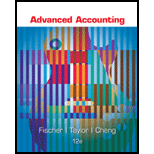
Consolidated financial statement and determination and distribution of excess income schedule
Consolidated financial statement are those kind of statement which contain consolidated financial information of subsidiary and holding company. In this elimination is made in controlling part also.
In determination and distribution of excess income schedule Through this price paid for subsidiary equity is compared with predetermine imbalance which is occurred in the consolidated worksheet because of elimination of in the investment account against the underlying subsidiary equity.
To calculate:
Through the information given in the question, prepare consolidation worksheet with the supporting of determination and distribution of excess schedule.
Answer to Problem 3A.3AP
Harvard Company purchase Bart Company has fair value of
Explanation of Solution
Harvard company purchased
Step
| Value Analysis Schedule | Company Implied Fair Value | Parent Price | Non Controlling Interest |
| Fair value of subsidiary | |||
| Fair value of net assets excluding Goodwill | |||
| Goodwill |
Step
| Particulars | Company implied fair value | Parent price | Non Controlling Interest | |
| Fair value of subsidiary (a) | ||||
| Book value of interest acquired: | ||||
| Common stock | ||||
| Retained Earning | ||||
| Total Equity | ||||
| Interest Acquired | ||||
| Book Value(b) | ||||
| Excess of fair value over book value | ||||
| Adjustment of identifiable accounts | Adjustment | Life | Amortization per year | |
| Building | A | |||
| Goodwill | - | - | A | |
| Total |
A represent non controlling interest portion of excess of fair value over book.
Step
Bart Company income distribution
| Particulars | Amount | Particular | Amount |
| Amortization(Building Depreciation) | Internally generated net income | ||
| Adjusted income before tax | |||
| Non Controlling interest profit share in subsidiary | |||
| Controlling interest share |
Harvard Company income distribution
| Particular | Amount |
| Internally generated net income | |
| Non Controlling interest profit share in subsidiary | |
| Controlling interest share |
Step
| Particulars | Financial Statement | Elimination & Adjustments | Non- Controlling Interest | Consolidated | ||
| Harvard | Bart | Debit | Credit | |||
| Income Statement | ||||||
| Net Sales | - | - | - | |||
| Cost of Goods Sold | - | - | - | |||
| Other Expenses | - | - | - | |||
| Depreciation | - | - | ||||
| Subsidiary Loss | - | - | - | - | ||
| Net Income | - | - | - | - | ||
| Consolidated Income | - | - | - | - | - | |
| NCI (see income distribution schedule) | - | - | - | - | - | |
| Controlling Interest (see income distribution schedule) | - | - | - | - | - | |
| Retained Earnings Statements: | - | - | - | - | - | - |
| Balance, January 1,2016- Harvard | - | - | ||||
| - | - | - | - | - | ||
| Balance, January 1,2016- Bart | - | |||||
| - | - | - | - | - | ||
| Net Income (from Above) | - | - | ||||
| Dividend Declared | ||||||
| Balance, December 31, 2016 | - | - | - | - | ||
| NCI in Retained Earning December 2016 | - | - | - | - | - | |
| Controlling Interest in Retained Earnings, December 2016 | - | - | - | - | - | |
| Consolidated Balance Sheet: | ||||||
| Cash | - | - | - | |||
| Inventory, December 2016 | - | - | - | |||
| Investment in Bart | - | - | - | - | ||
| - | - | - | - | - | ||
| - | - | - | - | - | ||
| Land | - | - | - | |||
| Buildings and Equipment | - | |||||
| Goodwill | - | - | - | - | ||
| Current Liabilities | - | - | - | |||
| Bond Payable | - | - | - | - | ||
| Common Stock-Harvard | - | - | - | - | ||
| Paid in capital in excess of Par- Harvard | - | - | - | - | ||
| Common Stock- Bart | - | - | - | |||
| Retained Earnings-December 31,2016- | - | - | - | - | ||
| Retained Earnings Non Controlling Interest, December 31, 2016 | - | - | - | - | - | |
| Retained Earnings Controlling Interest, December 31, 2016 | - | - | - | - | - | |
| Total NCI | - | - | - | - | ||
| Totals | ||||||
Conclusion
Harvard Company purchase Bart Company has fair value of
Want to see more full solutions like this?
Chapter 3 Solutions
Advanced Accounting
 Financial AccountingAccountingISBN:9781305088436Author:Carl Warren, Jim Reeve, Jonathan DuchacPublisher:Cengage Learning
Financial AccountingAccountingISBN:9781305088436Author:Carl Warren, Jim Reeve, Jonathan DuchacPublisher:Cengage Learning
